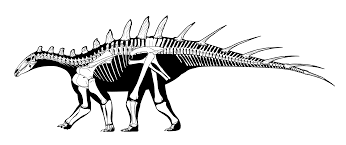Post by dinosauria101 on Jun 24, 2019 17:31:58 GMT 5
Torvosaurus tanneri (European)
Torvosaurus (play /ˌtɔrvɵˈsɔrəs/) is a genus of large theropod dinosaur that lived during the Late Jurassic period (mid-late Kimmeridgian stage in North America, early Tithonian stage in Europe). The name Torvosaurus means "savage lizard" and is derived from the Latin torvus ("savage") and the Greek σαυρος/sauros ("lizard"). Fossilized remains of Torvosaurus have been found in North America and Portugal. Torvosaurus reached 9 to 11 meters (30 to 36 ft) in length and an estimated weight of about 2 metric tons (2.2 tons), which made it the largest carnivore of its time, except for Epanterias (which may have been just a big Allosaurus) and Saurophaganax. The size of Torvosaurus is not definitely known because only incomplete material has been found, but it was a large theropod. Torvosaurus was a very large predator, with an estimated maximum body length of 10 metres (33 ft) and mass of 3.6–4.5 tonnes (4–5 short tons) for both T. tanneri and T. gurneyi, making Torvosaurus among the largest carnivores of the Jurassic.

Dacentrurus armatus
Dacentrurus (meaning "tail full of points"), originally known as Omosaurus, was a large stegosaur of the Late Jurassic Period (154 - 150 mya) of Europe. Its type species, Omosaurus armatus, was named in 1875, based on a skeleton found in the Kimmeridge Clay of England. In 1902 the genus was renamed Dacentrurus because the name Omosaurus had already been used for a crocodylian. After 1875, half a dozen other species would be named but perhaps only Dacentrurus armatus is valid. Finds of this animal have been limited and much of its appearance is uncertain. It was a heavily built quadrupedal herbivore, adorned with plates and spikes. Dacentrurus was a large stegosaurid. Some specimens reached lengths 10 meters (33 ft) and weighed 8 t (8.8 short tons). Many books claim that Dacentrurus was a small stegosaur, when in fact finds such as a 1.5 metres (4.9 ft) wide pelvis indicate that Dacentrurus was among the largest of them. For a stegosaur the gut was especially broad, and a massive rump is also indicated by exceptionally wide dorsal vertebrae centra. The hindlimb was rather short, but the forelimb relatively long, largely because of a long lower arm. Although Dacentrurus is considered to have the same proportions as Stegosaurus, its plate and spike configuration is known to be rather different, as it probably had both two rows of small plates on its neck and two rows of longer spikes along its tail. The holotype specimen of Dacentrurus armatus contained a small blunt asymmetrical neck plate and also included a tail spike which could have been part of a thagomizer. The tail spike had sharp cutting edges on its front and rear side. Dacentrurus has sometimes been portrayed with a spike growing near the shoulder, similarly to a Kentrosaurus. Whether this portrayal is accurate or not is not yet determined.

Credit to Wikipedia
Torvosaurus (play /ˌtɔrvɵˈsɔrəs/) is a genus of large theropod dinosaur that lived during the Late Jurassic period (mid-late Kimmeridgian stage in North America, early Tithonian stage in Europe). The name Torvosaurus means "savage lizard" and is derived from the Latin torvus ("savage") and the Greek σαυρος/sauros ("lizard"). Fossilized remains of Torvosaurus have been found in North America and Portugal. Torvosaurus reached 9 to 11 meters (30 to 36 ft) in length and an estimated weight of about 2 metric tons (2.2 tons), which made it the largest carnivore of its time, except for Epanterias (which may have been just a big Allosaurus) and Saurophaganax. The size of Torvosaurus is not definitely known because only incomplete material has been found, but it was a large theropod. Torvosaurus was a very large predator, with an estimated maximum body length of 10 metres (33 ft) and mass of 3.6–4.5 tonnes (4–5 short tons) for both T. tanneri and T. gurneyi, making Torvosaurus among the largest carnivores of the Jurassic.

Dacentrurus armatus
Dacentrurus (meaning "tail full of points"), originally known as Omosaurus, was a large stegosaur of the Late Jurassic Period (154 - 150 mya) of Europe. Its type species, Omosaurus armatus, was named in 1875, based on a skeleton found in the Kimmeridge Clay of England. In 1902 the genus was renamed Dacentrurus because the name Omosaurus had already been used for a crocodylian. After 1875, half a dozen other species would be named but perhaps only Dacentrurus armatus is valid. Finds of this animal have been limited and much of its appearance is uncertain. It was a heavily built quadrupedal herbivore, adorned with plates and spikes. Dacentrurus was a large stegosaurid. Some specimens reached lengths 10 meters (33 ft) and weighed 8 t (8.8 short tons). Many books claim that Dacentrurus was a small stegosaur, when in fact finds such as a 1.5 metres (4.9 ft) wide pelvis indicate that Dacentrurus was among the largest of them. For a stegosaur the gut was especially broad, and a massive rump is also indicated by exceptionally wide dorsal vertebrae centra. The hindlimb was rather short, but the forelimb relatively long, largely because of a long lower arm. Although Dacentrurus is considered to have the same proportions as Stegosaurus, its plate and spike configuration is known to be rather different, as it probably had both two rows of small plates on its neck and two rows of longer spikes along its tail. The holotype specimen of Dacentrurus armatus contained a small blunt asymmetrical neck plate and also included a tail spike which could have been part of a thagomizer. The tail spike had sharp cutting edges on its front and rear side. Dacentrurus has sometimes been portrayed with a spike growing near the shoulder, similarly to a Kentrosaurus. Whether this portrayal is accurate or not is not yet determined.
Credit to Wikipedia


